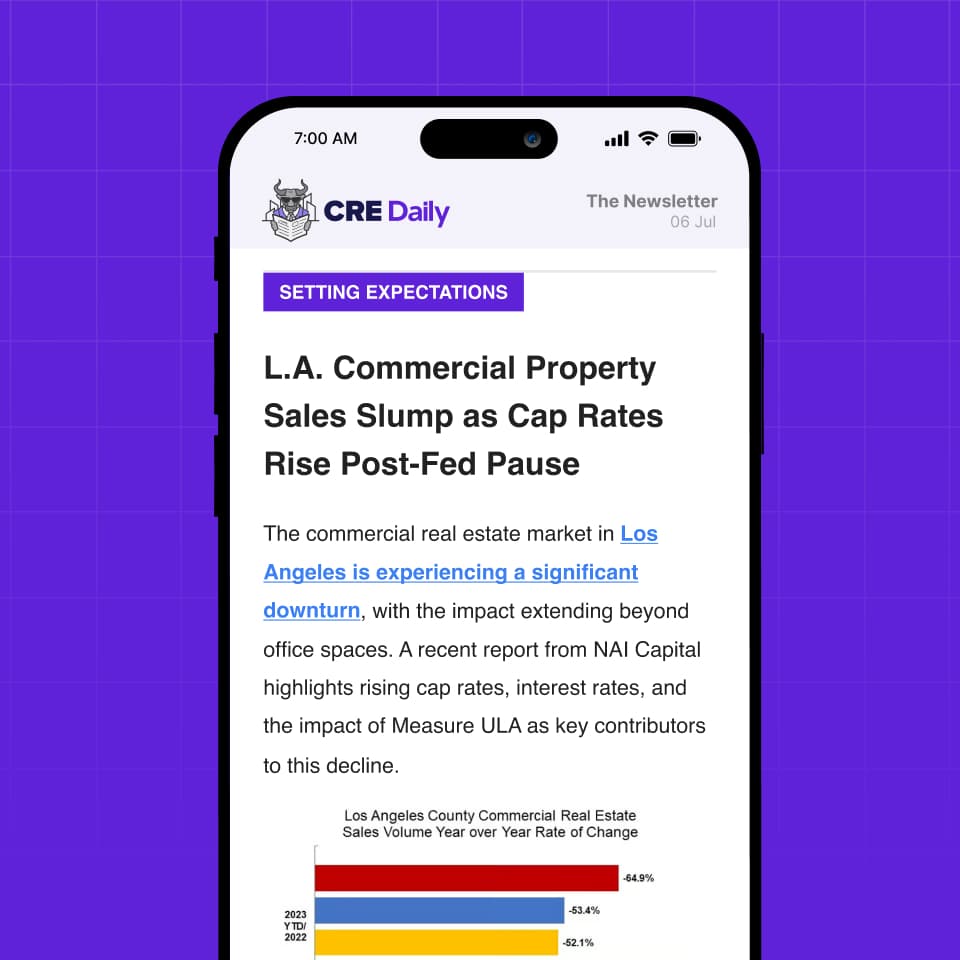California Wants More Apartments Near Transit. L.A. Isn’t Onboard.
SB79 could spark new multifamily projects across California if local politics don’t stall it first.
Good morning. California just made it easier to build apartments near transit, aiming to chip away at its housing shortage. But LA city leaders say the new law tramples local control and could reshape neighborhoods overnight.
Today’s issue is brought to you by Re-Leased—learn the five pillars every landlord and manager should master.
🎙️This week on No Cap: Fundrise CEO Ben Miller explains how his $7B platform is using data, AI, and creative financing to open new doors for everyday investors.
Market Snapshot
|
|
||||
|
|
*Data as of 10/09/2025 market close.
Zoning Wars
California Wants More Apartments Near Transit. L.A. Isn’t Onboard.
A new California housing law aims to speed up apartment development near transit—but Los Angeles isn’t on board.
Newsom targets housing: Governor Gavin Newsom signed SB79, a landmark housing law that streamlines apartment construction near major transit stops. The measure aims to boost supply in areas long constrained by high costs and restrictive zoning. Newsom called it both an economic and quality-of-life fix, promising “shorter commutes, lower costs, and more time with family.”
L.A. pushed back: Mayor Karen Bass and several city council members opposed the bill, saying it strips local control over land use. Bass called SB79’s rigid timelines “unnecessary burdens,” while Councilwoman Traci Park warned it could “open the floodgates to developers” and fuel displacement in established neighborhoods.
Housing tension grows: California’s housing struggle pits the state’s demand for new homes against local resistance to density. Nearly 75% of L.A.’s residential land is zoned for single-family homes, helping explain why it approved 63% fewer housing units this year than Dallas, despite a larger population.

Compromises and constraints: To win passage, lawmakers limited SB79’s reach to eight highly urbanized counties and scaled back union labor requirements for smaller buildings. The law pairs with Newsom’s rollback of environmental reviews long blamed for project delays. Still, high land, labor, and financing costs could slow near-term development.
Building up, not out: California’s geography and wildfire risks limit new sprawl, pushing the state toward vertical growth around transit nodes. In L.A.’s Rancho Park neighborhood, where zoning around a Metro stop has long favored single-family homes, SB79 could now permit 65-foot-tall apartments within a quarter mile.
Street-level sentiment: Community reactions are mixed. Longtime residents worry about congestion and neighborhood change, while commuters see more housing near transit as a practical solution. Many agree the issue is complex—too much uniformity risks backlash, but inaction worsens the housing and homelessness crisis.
➥ THE TAKEAWAY
Big picture: SB79 marks a turning point in California’s battle over who gets to decide where and how housing gets built. While the law could reshape urban neighborhoods, its real test lies in whether economics—and local politics—allow the promised construction boom to actually take root.
TOGETHER WITH RE-LEASED
Is your business built for long-term success?
From daily operations to financial health, successful property businesses are built on the right systems. Our free playbook not only shows what matters most but also gives you actionable steps, success measures, and tools to improve. Inside, you’ll find the 5 pillars every landlord and manager should master:
-
Lease & Tenant Management
-
Property Operations
-
Financial Operations
-
Compliance & Governance
-
Stakeholder Relations
Download the playbook and take our free 2-minute scorecard for tailored results on where to focus next.
*This is a paid advertisement. Please see the full disclosure at the bottom of the newsletter.
✍️ Editor’s Picks
-
Redefining capital efficiency: From tenant improvements to creative sale-leaseback structures, Dolfin helps landlords and tenants maximize value and efficiency across markets. (sponsored)
-
Zoning boost: The Senate passed the ROAD to Housing Act to ease the housing shortage by reforming zoning and supporting rural and multifamily development.
-
Debt dominance: U.S. REITs raised $21.3B in Q3, with debt offerings accounting for two-thirds of the total.
-
Warning signs: U.S. property repossessions jumped 33% in Q3 2025, signaling rising borrower strain as foreclosure activity continues its steady climb.
-
Fund flow: Nontraded REITs have cleared nearly all investor withdrawal requests—except for Starwood's SREIT, which still holds a $1B backlog.
-
Flood gamble: With the federal program paused, Neptune Insurance is betting tech and pricing power can make flood coverage a profitable private market.
-
HUD freeze: The prolonged government shutdown is straining HUD programs and creating uncertainty for affordable housing and CRE markets.
-
Risk rising: With NYC flood losses projected to hit $215M by 2030, local building owners are being urged to invest in climate adaptation or risk costly downtime.
🏘️ MULTIFAMILY
-
Historic disruption: A major water line rupture and electrical failure has rendered Dallas’ historic Mercantile Building uninhabitable, forcing lease terminations for over 175 residents.
-
Stable burbs: Suburban multifamily properties are holding firm amid market shifts, with steady occupancy, limited new supply, and affordability fueling investor interest.
-
Constant chaos: Election uncertainty and looming Medicaid reforms are putting senior housing operators on edge, as political chaos becomes a constant in the fight for funding.
-
Affordable pockets: The $1,000 apartment is vanishing in most U.S. cities, but it still survives in select Midwest and Southern metros.
🏭 Industrial
-
Bloom boom: Bloom Energy stock surged 20% after Brookfield Asset Management committed up to $5B to deploy its fuel cells in AI-powered data centers.
-
Farm for fiber: Fauquier County Supervisor Daron Culbertson defends selling his family farm to a data center developer, citing economic pressures despite public criticism.
-
Mixed metrics: Greater LA’s industrial market just posted its strongest leasing activity since 2020, even as rents continue to fall and vacancy ticks up.
-
Slow build: New Jersey’s industrial pipeline is cooling, with construction and deliveries down while vacancy climbs to 11.2%.
-
Phoenix first: Provident Industrial has completed its first Phoenix-area project—a 292K SF Class A warehouse in Glendale—entering one of the nation’s hottest industrial markets.
-
Takeover target: Blackstone is considering a bid for UK self-storage firm Big Yellow, as discounted REITs continue to draw private equity interest.
🏬 RETAIL
-
Mall money: Major banks are ramping up lending to top-tier U.S. malls, betting on luxury-anchored centers in strong markets.
-
Value eats: Budget-conscious consumers are increasingly skipping fast food and fast-casual restaurants in favor of value-focused grocery retailers for affordable meals.
-
Garden luxury: Dolce & Gabbana, Casa Tua, and Los Mochis will anchor the $10B One Beverly Hills project, blending luxury retail with 10 acres of botanical gardens.
-
Scaling back: Orvis will shut 36 stores in 2026 to cut costs and refocus on core outdoor gear amid rising tariffs.
🏢 OFFICE
-
Office rebound: U.S. office availability declined for the fifth straight quarter, signaling the sector’s first sustained recovery in nearly a decade.
-
Space reimagined: Retail-to-office conversions are gaining traction as developers repurpose vacant malls and big-box stores into modern workspaces.
-
Biotech commitment: Invivoscribe renewed its 52,477-square-foot headquarters lease at Nuveen’s renovated life sciences building in San Diego’s Sorrento Mesa submarket.
-
Refi of the day: BXP and Delaware North secured a $465M loan to refinance part of Boston’s mixed-use Hub on Causeway.
🏨 HOSPITALITY
-
Investor confidence: Despite a cautious market, major hotel deals closed in Q3 2025, led by BRE Hotels’ $300M purchase of EAST Miami, showing continued investor interest in high-value hospitality assets.
-
Manhattan money: Smith Hill Capital and Bain Capital completed a $216M refinancing of the 774-room Westin New York Grand Central Hotel.
A MESSAGE FROM HAH PARKING
Refer Parking Lots. Make Money
HAH Parking is the all-in-one parking management platform designed to boost performance and profitability.
Our cloud-based system helps lot owners earn more from every space without upfront expenses or long-term commitments.
Through the HAH Affiliate Program, CRE professionals receive 50% of gross profits for 12 months on every lot they refer.
The result is simple: owners gain higher returns, and you build a new revenue stream.
*This is a paid advertisement. Please see the full disclosure at the bottom of the newsletter.
📈 CHART OF THE DAY

San Antonio, Memphis, and Greensboro were the nation’s most affordable large apartment markets in September 2025, each with average rents under $1,300.

You currently have 0 referrals, only 1 away from receiving Multifamily Stress Test Model.
What did you think of today's newsletter? |























